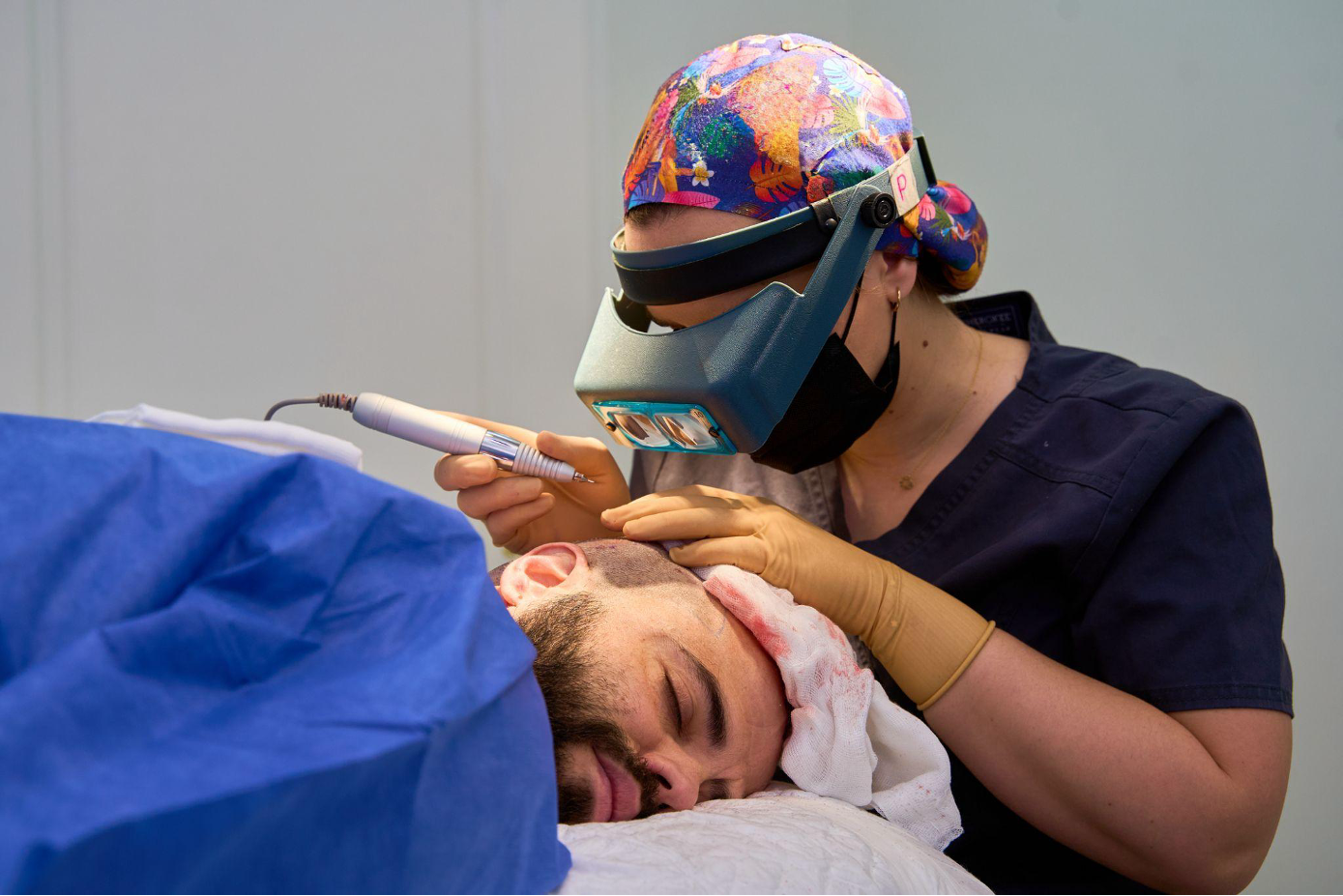
The future of hair restoration is being shaped by the latest hair restoration techniques, including minimally invasive procedures and advanced technologies. Innovations such as robotic follicular unit extraction and platelet-rich plasma therapy are revolutionizing outcomes for patients. Non-surgical options like microneedling and low-level laser therapy are also gaining traction. These advancements focus on improving natural aesthetics, reducing recovery times, and offering personalized solutions to address various forms of hair loss effectively.
Table of Contents
- Exploring the Latest Hair Restoration Techniques
- How New Technology for Hair Loss is Revolutionizing the Industry
- Modern Hair Transplant Options: What Patients Can Expect
- The Role of Non-Surgical Methods in Hair Restoration Advancements
- Final Thoughts on the Evolution of Hair Restoration Practices
Hair loss is a condition with a significant impact on millions of people worldwide causing a high demand to find effective solutions. Genetic causes are not the only solutions that people are seeking, as the traditional remedies are not enough. The hair restoration industry has grown tremendously and the recent hair restoration methods are combining science, technology and art to provide a natural appearance of the result.
In recent years, innovations such as robotic follicular unit extraction and platelet-rich plasma therapy have transformed the industry. For those exploring options, visit the site to learn about state-of-the-art procedures tailored to individual needs. As research continues, the focus remains on creating minimally invasive methods that reduce recovery times while maximizing graft viability.
Exploring the Latest Hair Restoration Techniques
Hair restoration has come a long way from its early days of basic grafting methods. Today, advancements in medical science and technology have paved the way for innovative solutions that deliver natural, long-lasting results.
Among these, Follicular Unit Extraction (FUE) and Follicular Unit Transplantation (FUT) stand out as two of the most effective techniques available. These methods cater to different patient needs, depending on factors such as donor area availability, desired hair density, and lifestyle preferences.
Understanding FUE and FUT
- FUE (Follicular Unit Extraction):
FUE is widely regarded as one of the best hair restoration methods, it involves extracting individual follicular units from the donor area using motorized punch devices. Each graft is carefully placed into the recipient area, leaving minimal scarring and allowing patients to wear shorter hairstyles post-procedure. - FUT (Follicular Unit Transplantation):
In this method, a strip of tissue is removed from the donor area and dissected under microscopes into individual grafts. FUT is ideal for patients requiring larger sessions or those with limited donor density, as it maximizes graft yield.
Both procedures are performed under local anesthesia and adhere to strict protocols to ensure graft viability and aesthetic outcomes.
How New Technology for Hair Loss is Revolutionizing the Industry
The hair restoration industry is undergoing a technological renaissance, driven by breakthroughs that enhance precision, efficiency, and patient outcomes. Besides mentioned new technology for hair loss, robotic systems and platelet-rich plasma (PRP) therapy are transforming how procedures are performed and how patients experience recovery.
Robotic Systems in Hair Restoration
Robotic-assisted Follicular Unit Extraction (FUE) has emerged as a game-changer in the field. Unlike traditional manual methods, robotic systems use advanced algorithms and imaging technology to:
- Identify optimal follicular units for extraction based on density and angle.
- Automate the extraction process, reducing human error and ensuring consistency.
- Minimize transection rates, preserving graft viability and improving overall outcomes.
This level of precision not only enhances the aesthetic design of the recipient area but also supports faster healing times, making it an attractive option for individuals seeking minimally invasive solutions.
Platelet-Rich Plasma (PRP) Therapy
PRP therapy leverages the body’s natural healing mechanisms to stimulate dormant hair follicles. The process involves:
- Drawing a small amount of the patient’s blood and centrifuging it to isolate growth factors.
- Injecting the concentrated plasma into thinning or balding areas to promote cellular activity.
When combined with surgical interventions like FUE or FUT, PRP therapy can enhance graft survival and accelerate recovery. Additionally, microneedling – a technique often paired with PRP – creates controlled micro-injuries to improve product absorption and follicular stimulation.
The Role of Adjunctive Therapies
While surgical techniques remain the cornerstone of hair restoration, adjunctive therapies such as finasteride and minoxidil play a critical role in stabilizing hair loss. These FDA-approved medications work synergistically with surgical interventions to:
- Slow down the progression of androgenetic alopecia.
- Maintain existing hair density while new grafts mature.
This technological evolution underscores the importance of staying informed about the latest advancements in hair restoration, empowering patients to make educated decisions about their treatment options.
Modern Hair Transplant Options: What Patients Can Expect
Hair transplant surgery has evolved into a highly sophisticated procedure, offering patients natural-looking results with minimal downtime. Its methods cater to diverse patient needs, ensuring optimal outcomes based on individual candidacy assessments:
| Technique | Benefits | Best For |
| Follicular Unit Extraction (FUE) | – Minimal scarring- Allows shorter hairstyles post-procedure- Natural-looking results | Patients requiring smaller sessions or those preferring minimal scarring and flexibility in hairstyle. |
| Follicular Unit Transplantation (FUT) | – Maximizes graft yield- Ideal for larger sessions- Suitable for limited donor density | Patients needing larger graft numbers or those with limited donor availability. |
| Facial Hair Restoration | – Mimics natural growth patterns- Seamless blend with existing hair- Enhances facial aesthetics | Individuals seeking eyebrow reconstruction or beard transplantation for aesthetic or reconstructive purposes. |
| Adjunctive Therapies | – Stimulates dormant follicles- Maintains existing hair density- Supports long-term results | Patients in early stages of hair loss or those seeking non-surgical maintenance alongside transplants. |
These advancements in modern hair transplant options highlight the industry’s commitment to precision, innovation, and patient satisfaction, setting new benchmarks for excellence in hair restoration.
The Role of Non-Surgical Methods in Hair Restoration Advancements
While surgical techniques like FUE and FUT dominate the field of hair restoration, non-surgical methods in hair restoration advancements are gaining recognition as effective complements or alternatives for individuals seeking to address hair loss.
These approaches, including platelet-rich plasma (PRP) therapy, microneedling, and FDA-approved medications like finasteride and minoxidil, offer versatile solutions tailored to different stages of hair thinning and patient preferences.
Platelet-Rich Plasma (PRP) Therapy: Harnessing the Body’s Healing Power
PRP therapy has emerged as a cornerstone of non-surgical hair restoration, leveraging the body’s natural regenerative capabilities. The process involves:
- Drawing a small amount of the patient’s blood and centrifuging it to isolate growth factors.
- Injecting the concentrated plasma into areas affected by hair thinning to stimulate dormant follicles and promote cellular activity.
When combined with microneedling – a technique that creates controlled micro-injuries to enhance product absorption – PRP therapy can significantly improve follicular health and density. Multiple sessions are typically required to achieve optimal results, making this treatment ideal for patients in the early stages of hair loss.
Microneedling: Enhancing Treatment Efficacy
Microneedling is often used alongside PRP or topical treatments to maximize their impact. This procedure:
- Creates tiny channels in the scalp, allowing deeper penetration of therapeutic agents.
- Stimulates collagen production and improves blood circulation, creating a healthier environment for hair growth.
Performed in-clinic by trained professionals, microneedling is a minimally invasive option that supports long-term follicular health without the need for surgery.
FDA-Approved Medications: Stabilizing Hair Loss
For individuals with androgenetic alopecia, medications like finasteride and minoxidil play a critical role in stabilizing hair loss. These treatments work synergistically with other interventions to:
- Slow down the progression of hair thinning by targeting hormonal imbalances.
- Maintain existing hair density while promoting new growth in responsive areas.
Oral finasteride (1 mg daily) is particularly effective for male patients, while topical minoxidil formulations (2% or 5%) cater to both men and women. However, consistent use and regular monitoring are essential to sustain results.
This evolution underscores the importance of personalized care in modern hair restoration, offering innovative pathways to achieving natural, sustainable outcomes.
Final Thoughts on the Evolution of Hair Restoration Practices
A combination of new state-of-the-art surgery and non-surgical options determines the future of hair restoration. Robotic-assisted FUE to platelet-rich plasma therapy, these improvements focus on accuracy, natural outcomes, and patient care services.
With the help of the newest approaches to restoring hair, people should not be afraid of the issue as new technologies will focus on both beauty and the results in the long run. With research constantly pushing limits, keeping up with the trends will be one of the most efficient ways to be offered the most effective and sustainable options at present.




